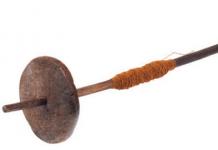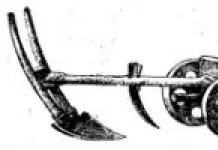If you ask the question, what thing is of paramount importance in the everyday life of a modern person, the answers will be different. Perhaps they will name soap, furniture, dishes ... And yet, without such useful things without a dispute, you can somehow get by, although it is not even easy to imagine. But if fabric completely disappears from everyday life, then the world around us, you see, will change beyond recognition. After all, clothes are sewn from fabric, not to mention many other applications of this material.
So the invention of yarn - threads from wool or plant fibers - and the method of making fabric from yarn are incredibly significant achievements for mankind. And it is not at all accidental that perhaps the first production processes that people tried to mechanize were just the manufacture of yarn and fabric. Moreover, technical advances in this area, as it were, spurred inventive thought in other directions. Perhaps not everyone knows that the industrial revolution of the 18th century, which led to the mass appearance of a variety of machines, began precisely with the invention of a fairly perfect loom.
However, about how a person became a weaver, it is better, of course, to tell in order ...
The oldest fabric samples that have survived to this day are several thousand years old. Archaeologists have repeatedly found thin linen linen in ancient Egyptian tombs, as well as denser material, painted with color drawings. Due to the fact that Egypt has a dry climate and there are no sharp temperature changes, the ancient fabric is well preserved.
According to these archaeological finds, it can be judged that the work of the ancient Egyptian weavers was of very high quality, although they made the fabric by hand. Under a strong magnifying glass, it is clearly seen that the threads of ancient fabrics are intertwined very neatly, lying, both along and across, in even, straight lines. However, why be surprised: the ancient Egyptians were far from the first weavers - people began to learn the art of weaving threads to make fabrics from them thousands of years before the Egyptian civilization. And they were prompted by an even more ancient skill - weaving baskets, bedding, nets, shoes from flexible branches, reeds, long shoots of grass. This was already known to our distant primitive ancestors.
However, none of these materials was suitable for the manufacture of fabrics. But even here nature itself came to the aid of primitive man. Inquisitive ancestors noticed that from many plants, such as flax, cotton, hemp and even nettles, elastic and durable fibers can be extracted.
Suitable for this and the wool of domestic animals. But in order to make yarn from fibers, one had to work hard. Extracting fibers from flax stalks, for example, is particularly difficult. And the wool must first be cleaned, rinsed thoroughly, and dried. Long strong threads were twisted from the prepared raw materials. This process is called spinning, and the resulting threads are called yarn. And already thousands of years ago, man tried to somehow rationalize spinning by inventing a spindle - a rod made of wood or stone, on which a finished thread was wound. It had to be twisted manually, gradually pulling bundles of fibers from the prepared raw material. Looking ahead a little, it is worth saying that, in the end, man invented the spinning wheel. Now the spinner turned the wheel by hand, connected to the spindle by a belt drive. Rotating, the spindle itself gradually pulled out bundles of fibers, turning them into threads of yarn. Well, as for the fabric manufacturing process, it also gradually rationalized. True, at the dawn of weaving it was quite simple.
One can imagine with the help of some simple devices primitive weavers worked. Two strong branches with flyers at the top were driven into the ground. They were holding a wooden rod. Approximately the same device, only lower, is made on a hiking trip to hang a kettle over a fire. Ancient weavers tied to this rod, one next to the other, threads of yarn hanging down to the ground. To prevent them from tangling, weights were attached to their ends. By the way, to this day these longitudinal threads are called the basis in textile production. To turn the warp into a fabric, the longitudinal threads must be interlaced with transverse ones, which are called weft.
The process itself was simple, albeit time-consuming. The weaver passed the weft through the warp in such a way that it passed, for example, over the even threads and under the bottom of the odd ones, and vice versa in the opposite direction. It was most convenient to do this with a pointed stick, on which the weft thread was wound. At the same time, it was necessary to ensure that the threads lay evenly and tightly one to the other. So gradually the threads turned into fabric. It could be different - light from linen yarn, rough and warm from woolen. Be that as it may, primitive man finally got the opportunity to put on clothes sewn from cloth. He learned to sew even earlier, making robes from animal skins...
Gradually weaving production improved. At first, the ancient inventors figured out: if you raise all the even or odd warp threads at once, then the ducks can be thrown under them to the other side in one motion. Therefore, at the ends of the warp threads, wooden planks called remez appeared. Even threads were attached to one plank, odd threads to the other. The master, lifting one remez, then another, successively separated the threads from each other and threw the ducks from right to left, then from left to right. The weaving process has become ten times faster. It only remained to guess that with the help of additional remes it is possible to raise other warp threads in a certain order, making their interlacing with the weft more difficult. Thus, a certain pattern could be obtained on the fabric. Weavers widely used such "tricks" already in ancient times.
Gradually, the loom became just a loom. In the Middle Ages, for example, the master controlled remez by pressing the pedals with his feet, while his hands remained free. Ducks could be thrown to the right, then to the left much faster, labor productivity increased. However, the fabric turned out to be narrow, just as long as the length of the weaver's arm was enough.
But then, finally, the 18th century came, when the most important changes took place in the textile industry. This is the merit of the English inventors John Kay and Edmund Cartwright. The first of them in 1733 came up with the design of a mechanical shuttle for weft thread. The shuttle moved along the guides, dragging the thread behind it, driven by the blows of special wooden hammers, reinforced on both sides of the machine frame. After each movement of the shuttle, the base wound on the roller moved forward one “step”, making room for a new “stitch”. John Kay's shuttle was called "aircraft".
Just with this invention, we can assume that the industrial revolution began. The fact is that looms with a shuttle-plane made it possible to produce much more fabrics than before. Weaving enterprises began to run out of yarn, which was still produced by hand. They had to invent a spinning machine, which was done in 1765 by another English inventor, James Hargreaves. A few years later, spinning mills appeared in England, the machines of which were powered by water engines.
Finally, in the mid-80s, Edmund Cartwright invented the loom, where all operations were mechanized. Just at that time, another Englishman, James Watt, completed work on his steam engine. And Cartwright built a weaving factory with twenty looms, installing Watt's machine to drive them. So the first widespread use of the steam engine was found in the weaving industry.
Of course, in the future, the loom was continuously improved. Of particular note is the French inventor Joseph Marie Jacquard. In 1801, he created... a programmable loom. For this, punch cards were used - cardboard plates with holes punched into them in a certain order. Punched cards were connected in a tape that was placed on top of the machine. Each punched card in a certain way controlled the movements of the warp threads, “setting” the machine a program for creating a particular pattern on the fabric. By pressing the pedal, the master could move the strip of punched cards and change the program. Later, with the help of punched cards, they began to set programs for metal-cutting machines, but the first was weaving!
Well, modern looms are complex, well-designed units. They have different designs - there are multi-shuttle machines, and there are machines without shuttles - the weft thread transfers compressed air. But the very main principle of making fabrics by interweaving warp and weft remained the same as that invented by primitive man.
Igorev, V. As from a loom... the industrial revolution began /V. Igorev // Why?. - 2008. - No. 10. - S. 24-26.
loom. First inventor's name loom unknown. However, the principle laid down by this man is still alive: the fabric consists of two systems of threads located mutually perpendicular, and the task of the machine is to intertwine them.
First fabrics, made more than six thousand years ago, in the Neolithic era, have not reached us. However, the evidence for their existence is loom parts- you can see.
At first, the threads were interlaced with the help of manual force. Even Leonardo da Vinci, no matter how hard he tried, could not invent a mechanical loom. Until the 18th century, this task seemed insurmountable. And only in 1733, a young English cloth maker John Kay made the first mechanical (aka aircraft) shuttle for a hand loom. The invention eliminated the need to manually thread the shuttle and made it possible to produce wide fabrics on a machine operated by one person (previously two were required).
Kay's work was continued by the most successful weaving reformer, Edmund Cartwright. Curiously, he was a pure humanist by training, an Oxford graduate with a Master of Arts degree. In 1785 Cartwright received a patent for mechanical loom with a foot drive and built a spinning and weaving factory for 20 such devices in Yorkshire. But he did not stop there: in 1789 he patented a combing machine for wool, and in 1792 - a machine for twisting ropes and ropes.
The Cartwright machine in its original form was still so imperfect that it did not pose any serious threat to hand weaving. Therefore, until the first years of the 19th century, the position of the weavers was incomparably better than the spinners, their incomes showed only a barely noticeable downward trend. As early as 1793, "the weaving of kisei was a gentleman's craft. The weavers looked like high-ranking officers in all their appearance: in fashionable boots, a ruffled shirt and with a cane in their hand, they went for their work and sometimes brought it home in a carriage.
In 1807, the British Parliament sent a memorandum to the government stating that the inventions of the Master of Arts contributed to the welfare of the country (and this is true, England was not for nothing known as the “workshop of the world”). In 1809, the House of Commons allocated 10,000 pounds to Cartwright - money that was completely unthinkable at that time. After that, the inventor retired and settled on a small farm, where he was engaged in the improvement of agricultural machines.
Machine Cartwright almost immediately began to improve and modify. And no wonder, because the profit weaving mills gave serious, and not only in England. In the Russian Empire, for example, thanks to the development of weaving in the 19th century, Lodz turned from a small village into a huge city by then standards with a population of several hundred thousand people. Millions of fortunes in the empire often made money precisely in the factories of this industry - just remember the Prokhorovs or Morozovs.
Already by the 30s, a lot of technical improvements were added to the Cartwright machine. As a result, there were more and more such machines in the factories, and ever fewer workers served them.
New obstacles stood in the way of a steady increase in labor productivity. The most time-consuming when working on mechanical machines were the change and charging of the shuttle. For example, when making the simplest chintz on a Platt machine, the weaver spent up to 30% of the time on these operations. Moreover, he had to constantly monitor the breakage of the main thread and stop the machine to eliminate deficiencies. In this state of affairs, it was not possible to expand the service area. Only after the Englishman Northrop invented a method for automatically charging the shuttle in 1890 did factory weaving make a real breakthrough. Already in 1996, Northrop developed and brought to market the first automatic loom. This further allowed the zealous manufacturers to save considerably on salaries. Then came the serious a competitor to an automatic loom - a weaving machine without a shuttle at all, which greatly increased the possibility of servicing several devices by one person. Modern looms are developing in the computer and automatic directions familiar to many technologies. But the main thing was done more than two centuries ago by the inquisitive Cartwright.
Weaving radically changed the life and appearance of a person. Instead of animal skins, people dressed in clothes made from linen, woolen or cotton fabrics, which have since become our constant companions. However, before our ancestors learned to weave, they had to master the technique of weaving to perfection. Only having learned to weave mats from branches and reeds, people could begin to "weave" the threads.
Spinning and weaving workshop. Painting from a tomb in Thebes. Ancient Egypt
The process of fabric production is divided into two main operations - obtaining yarn (spinning) and obtaining canvas (actually weaving). Observing the properties of plants, people noticed that many of them contain elastic and flexible fibers. These fibrous plants, used by man already in ancient times, include flax, hemp, nettle, xanthus, cotton and others. After the domestication of animals, our ancestors obtained, along with meat and milk, a large amount of wool, also used for the production of fabrics. Before starting spinning, it was necessary to prepare the raw materials.

Spindle with spindle
Spinning fiber is the starting material for yarn. Without going into details, we note that the master needs to work hard before wool, linen or cotton turns into spinning fiber (this is most true for flax: the process of extracting fibers from the stem of plants is especially laborious here; but even wool, which, in fact, is already finished fiber, requires a number of preliminary operations for cleaning, degreasing, drying, etc.). But when the spinning fiber is obtained, it makes no difference to the master whether it is wool, linen or cotton - the process of spinning and weaving is the same for all types of fibers.

Spinner at work
The oldest and simplest device for the production of yarn was a hand spinning wheel, which consisted of a spindle, a whorl and the actual spinning wheel. Before starting work, the spinning fiber was attached to some stuck branch or a stick with a fork (later this knot was replaced by a board, which was called the spinning wheel). Then the master pulled a bundle of fibers from the ball and attached it to a special device for twisting the thread. It consisted of a stick (spindle) and a whorl (which served as a round stone with a hole in the middle). The whorl was mounted on a spindle. The spindle, together with the beginning of the thread screwed to it, was brought into rapid rotation and immediately released. Hanging in the air, it continued to rotate, gradually stretching and twisting the thread.
The whorl served to increase and maintain the rotation, which would otherwise stop after a few moments. When the thread became long enough, the craftswoman wound it around the spindle, and the whorl did not allow the growing ball to slip off. Then the whole operation was repeated. Despite its simplicity, the spinning wheel was an amazing conquest of the human mind. Three operations - stretching, twisting and winding of the thread were combined into a single production process. Man got the ability to quickly and easily turn the fiber into a thread. Note that in later times nothing fundamentally new was introduced into this process; it was just transferred to the machines.
After receiving the yarn, the master proceeded to the fabric. The first looms were vertical. They consisted of two forked-shaped bars inserted into the ground, on the forked ends of which a wooden rod was laid transversely. To this crossbar, which was placed so high that it was possible to reach it while standing, they tied one thread next to the other, which formed the basis. The lower ends of these threads hung freely almost to the ground. So that they do not get tangled, they were pulled with suspensions.

Loom
Starting work, the weaver took the duck in her hand with a thread tied to it (a spindle could serve as a duck) and passed it through the warp in such a way that one hanging thread remained on one side of the duck, and the other on the other. A transverse thread, for example, could pass over the first, third, fifth, etc. and under the bottom of the second, fourth, sixth, etc. warp threads, or vice versa.
This method of weaving literally repeated the technique of weaving and required a very long time to pass the weft thread either over or under the bottom of the corresponding warp thread. For each of these threads, a special movement was necessary. If there were one hundred threads in the warp, then one had to make one hundred movements to thread the weft in only one row. Soon, the ancient masters noticed that the weaving technique could be simplified.
Indeed, if it were possible to immediately raise all the even or odd warp threads, the master would be spared the need to slip the ducks under each thread, but could immediately stretch it through the entire warp: a hundred movements would be replaced by one! A primitive device for separating threads - remez was invented already in antiquity. At first, a simple wooden rod served as a remez, to which the lower ends of the warp threads were attached through one (so, if the even ones were tied to the remez, then the odd ones continued to hang freely). Pulling the remez, the master immediately separated all the even threads from the odd ones and with one throw threw the ducks through the entire warp. True, during the reverse movement, the duck again had to go through all the even threads one by one.
The work accelerated twice, but still remained laborious. However, it became clear in which direction to search: it was necessary to find a way to alternately separate either even or odd threads. At the same time, it was impossible to simply introduce a second Remez, because the first one would get in his way. Here a witty idea led to an important invention - laces began to be tied to weights at the lower ends of the threads. The second ends of the laces were attached to the remez boards (even to one, odd to the other). Now remez did not interfere with mutual work. Pulling first one remez, then another, the master successively separated either even or odd threads and threw the ducks over the warp.
Work has accelerated tenfold. The manufacture of fabrics ceased to be weaving and became actually weaving. It is easy to see that with the method described above of attaching the ends of the warp threads to the straps with the help of laces, not two, but more straps can be used. For example, it was possible to tie every third or every fourth thread to a special plank. In this case, the methods of weaving the threads could be obtained in a variety of ways. On such a loom, it was possible to weave not only calico, but also twill or satin fabric.
In subsequent centuries, various improvements were made to the loom (for example, they began to control the movement of the sheds with the help of a pedal with their feet, leaving the weaver's hands free), but the weaving technique did not fundamentally change until the 18th century. An important drawback of the described machines was that, pulling the ducks either to the right or to the left, the master was limited by the length of his arm. Usually the width of the canvas did not exceed half a meter, and in order to get wider stripes, they had to be sewn together.
A fundamental improvement in the loom was introduced in 1733 by the English mechanic and weaver John Kay, who created a design with an aircraft shuttle. The machine provided the threading of the shuttle between the warp threads. But the shuttle was not self-propelled: it was moved by a worker with the help of a handle connected to the blocks by a cord and setting them in motion. The blocks were constantly pulled by a spring from the middle of the machine to the edges. Moving along the guides, one or another block hit the shuttle. In the process of further development of these machines, an outstanding role was played by the Englishman Edmund Cartwright. In 1785, he created the first, and in 1792, the second design of a loom, which provides for the mechanization of all the main operations of hand weaving: hooking the shuttle, lifting the shaft, breaking the weft thread with a reed, winding the spare warp threads, removing the finished fabric and sizing the warp. A major achievement of Cartwright is the use of a steam engine to operate a loom.

Scheme of the self-propelled shuttle Kay (click to enlarge): 1 - guides; 2 - blocks; h - spring; 4 - handle; 5 - shuttle
Cartwright's predecessors solved the problem of mechanically driving a loom using a hydraulic motor.
Later, the famous creator of automata, the French mechanic Vaucanson, designed one of the first mechanical looms with a hydraulic drive. These machines were very imperfect. By the beginning of the industrial revolution, in practice, mainly hand looms were used, which, naturally, could not meet the needs of the rapidly developing textile industry. In a handloom, the best weaver could throw the shuttle over the shed about 60 times per minute, in a steam loom - 140.
A significant achievement in the development of textile production and a major event in the improvement of working machines was the invention by the Frenchman Jacquard in 1804 of a machine for patterned weaving. Jacquard invented a fundamentally new method of manufacturing fabrics with a complex large-pattern multi-color pattern, using a special device for this. Here, each of the warp threads passes through the eyes, made in the so-called faces. At the top, the faces are tied to vertical hooks, and weights are located below. A horizontal needle is connected to each hook, and they all pass through a special box that periodically reciprocates. On the other side of the device is a prism mounted on a rocking arm. A chain of perforated cardboard cards is put on the prism, the number of which is equal to the number of differently intertwined threads in the pattern and is sometimes measured in thousands. In accordance with the developed pattern, holes are made in the cards through which the needles pass during the next course of the box, as a result of which the hooks associated with them either take a vertical position or remain deflected.

Jacquard device 1 - hooks; 2 - horizontal needle; 3 - faces; 4 - eyes; 5 - weights; 6 - reciprocating box; 7 - prism; 8 - perforated cards; 9 - upper grille
The process of pharynx formation ends with the movement of the upper lattice, which drags along the vertically standing hooks, and with them the “faces” and those warp threads that correspond to the holes in the cards, after which the shuttle pulls the weft thread. Then the upper grate is lowered, the box of needles returns to its original position and the prism rotates, feeding the next card.
The Jacquard machine provided weaving with multi-colored threads, automatically performing various patterns. When working on this loom, the weaver did not need virtuosity at all, and all his skill should have consisted only in changing the programming card when weaving a fabric with a new pattern. The loom worked at a speed that was completely inaccessible to a weaver working by hand.
In addition to a complex and easily reconfigurable control system based on punched card programming, Jaccard's machine is remarkable for its use of the principle of servo action, embedded in the shedding mechanism, which was driven by massive linkage acting from a constant source of energy. In this case, only a tiny fraction of the power was expended in moving the hooked needles, and thus the high power was controlled by a small signal. The Jaccard mechanism provided automation of the work process, including pre-programmed actions of the working machine.
A significant improvement in the loom, leading to its automation, belongs to the Englishman James Narthrop. In a short time, he managed to create a device that automatically replaces an empty shuttle with a full one when the machine stops and on the go. The Nartrop machine had a special shuttle magazine, similar to the magazine of cartridges in a rifle. The empty shuttle was automatically ejected and replaced with a new one.
Interesting attempts to create a machine without a shuttle. Even in modern production, this direction is one of the most remarkable. Such an attempt was made by the German designer Johann Gebler. In his model, the warp thread was transmitted by means of anchors located on both sides of the loom. The movement of the anchors alternates and the thread is passed from one to the other.
In the machine, almost all operations are automated, and one worker can serve up to twenty such machines. Without a shuttle, the entire design of the machine turned out to be much simpler and its operation much more reliable, since such parts as the shuttle, runner, etc., which were most subject to wear, disappeared. In addition, and this is perhaps of paramount importance, the exclusion of the shuttle ensured noiseless movement, which only the design of the machine tool from shock and shock, but also workers from significant noise.
The technical revolution that began in the field of textile production quickly spread to other areas, where not only fundamental changes took place in the technological process and equipment, but new working machines were created: scutching machines - turning cotton bales into canvases, splitting and cleaning cotton, laying parallel to one to another fiber and pulling them out; carding - turning the canvas into a ribbon; tape - providing a more uniform composition of tapes, etc.
At the beginning of the XIX century. Special machines for spinning silk, flax, and jute became widespread. Machines for knitting, for weaving lace are being created. The hosiery knitting machine won great popularity, performing up to 1500 loops per minute, while the most agile spinner made no more than a hundred loops before. In the 80-90s of the XVIII century. machines for basic knitting are being designed. Create tulle and sewing machines. Singer sewing machines are the most famous.
The revolution in the method of manufacturing fabrics led to the development of such industries related to the textile industry as bleaching, calico printing and dyeing, which, in turn, forced attention to the creation of more advanced dyes and substances for bleaching fabrics. In 1785, C. L. Berthollet proposed a method for bleaching fabrics with chlorine. English chemist Smithson Tennant discovers a new method for making whitewash. Under the direct influence of textile processing technology, the production of soda, sulfuric and hydrochloric acid has developed.
Thus, technology gave science a certain order and stimulated its development. However, regarding the interaction of science and technology during the period of the industrial revolution, it should be emphasized that a characteristic feature of the industrial revolution of the late XVIII - early XIX century. there was relatively little connection with science. It was a revolution in technology, a revolution based on practical research. Wyatt, Hargreaves, Crompton were artisans, so the main revolutionary events in the textile industry occurred without much influence from science.
The most important consequence of the mechanization of textile production was the creation of a fundamentally new machine-factory system, which soon became the dominant form of labor organization, dramatically changing its nature, as well as the position of the workers.
April 4, 1785 Englishman Cartwright received a patent for a mechanical loom. The name of the inventor of the first loom is unknown. However, the principle laid down by this man is still alive: the fabric consists of two systems of threads located mutually perpendicular, and the task of the machine is to intertwine them.
The first fabrics, made more than six thousand years ago, in the Neolithic era, have not reached us. However, evidence of their existence - the details of the loom - can be seen.
At first, the threads were interlaced with the help of manual force. Even Leonardo da Vinci, no matter how hard he tried, could not invent a mechanical loom.

Until the 18th century, this task seemed insurmountable. And only in 1733, a young English cloth maker John Kay made the first mechanical (aka aircraft) shuttle for a hand loom. The invention eliminated the need to manually thread the shuttle and made it possible to produce wide fabrics on a machine operated by one person (previously two were required).

Kay's work was continued by the most successful weaving reformer, Edmund Cartwright.

Curiously, he was a pure humanist by training, an Oxford graduate with a Master of Arts degree. In 1785, Cartwright took out a patent for a mechanical foot-operated loom and built a spinning and weaving mill in Yorkshire for 20 such devices. But he did not stop there: in 1789 he patented a combing machine for wool, and in 1792 - a machine for twisting ropes and ropes.
The Cartwright machine in its original form was still so imperfect that it did not pose any serious threat to hand weaving.

Therefore, until the first years of the 19th century, the position of the weavers was incomparably better than the spinners, their incomes showed only a barely noticeable downward trend. As early as 1793, "the weaving of kisei was a gentleman's craft. The weavers looked like high-ranking officers in all their appearance: in fashionable boots, a ruffled shirt and with a cane in their hand, they went for their work and sometimes brought it home in a carriage.

In 1807, the British Parliament sent a memorandum to the government stating that the inventions of the Master of Arts contributed to the welfare of the country (and this is true, England was not for nothing known as the “workshop of the world”).

In 1809, the House of Commons allocated 10,000 pounds to Cartwright - money that was completely unthinkable at that time. After that, the inventor retired and settled on a small farm, where he was engaged in the improvement of agricultural machines.
Machine Cartwright almost immediately began to improve and modify. And no wonder, because weaving factories gave serious profits, and not only in England. In the Russian Empire, for example, thanks to the development of weaving in the 19th century, Lodz turned from a small village into a huge city by then standards with a population of several hundred thousand people. Millions of fortunes in the empire often made money precisely in the factories of this industry - just remember the Prokhorovs or Morozovs.
Already by the 30s, a lot of technical improvements were added to the Cartwright machine. As a result, there were more and more such machines in the factories, and ever fewer workers served them.
New obstacles stood in the way of a steady increase in labor productivity. The most time-consuming when working on mechanical machines were the change and charging of the shuttle. For example, when making the simplest chintz on a Platt machine, the weaver spent up to 30% of the time on these operations. Moreover, he had to constantly monitor the breakage of the main thread and stop the machine to eliminate deficiencies. In this state of affairs, it was not possible to expand the service area.
Only after the Englishman Northrop invented a method for automatically charging the shuttle in 1890 did factory weaving make a real breakthrough. Already in 1996, Northrop developed and brought to market the first automatic loom. This further allowed the zealous manufacturers to save considerably on salaries. A serious competitor to the automatic loom appeared next - a weaving machine without a shuttle at all, which greatly increased the possibility of servicing several devices by one person. Modern looms are developing in the computer and automatic directions familiar to many technologies. But the main thing was done more than two centuries ago by the inquisitive Cartwright. 


The introduction of the latest technologies in industrial sectors primarily affects equipment. Examples of various industries demonstrate the benefits of technical development, which is manifested in improving the quality of products. At the same time, there are areas where traditional methods of organizing technological processes are still relevant. In particular, the loom still retains the concept of the close relationship between manual labor and machine function to this day. Of course, in some areas of production, the emergence of electronic systems with automation can also be noted. However, in terms of the combination of advantages of the two approaches, the advantage still remains with manual and mechanical units.
General information about looms
Despite the conservative approach to textile production, participants in this segment use many variations of this machine. At the same time, all models serve the same purpose - the formation of tissue. As a result of the mutual interweaving of several threads with a certain arrangement configuration relative to each other, a textile product with a given structure is created. In general, the concept is simple, so its origins go back into history quite deeply. For example, the first finds that testify to the manufacture of fabrics by weaving date back about 6 thousand years. If we talk about machines that are close to modern technical means, then the first looms appeared in 1785. It was at this time that a mechanical unit of this type was patented. At the same time, it cannot be said that the device was something unprecedented and revolutionary. By this point, manual mechanisms had been quite common in Europe for almost a hundred years.
Main characteristics

A special place in the technical parameters is occupied by the dimensions of the machines. The most compact dimensions are traditional manual machines, which are easily placed even in a small apartment. They can be compared to a washing machine, but it is important to take into account the need to organize the workplace. One of the most important characteristics is the width of the fabric, which on average varies from 50 to 100 cm. Of course, a weaving machine for industrial needs can also have a two-meter wide fabric, which makes it possible to make carpets. Consideration should also be given to the dimensions of the installation, in terms of placement on the floor. As a rule, models from junior and medium lines occupy areas no larger than 100x100 cm. At the same time, the installation height can reach 1.5 m.
Machine device
The classic design of a manual machine primarily provides for the presence of two transverse bars for a commodity roller and a beam. As a rule, these elements are included in the basic package. The machine does not do without a thread holder. In the process of warping, it is for this part that the ends of the threads are fixed. A hook is designed to thread the loops of yarn into the corresponding teeth. This detail is also called a plug in a reed. In addition, the device of the loom provides for the presence of embedded strips. With these elements, the user can keep the base flat and smooth. Planks are usually laid on the base as they are wound. When the formation of the base on the machine begins, the shaft holder function is necessary - it is performed by a special lock included in the kit. As an option, kits with wire studs are also available, which secure the healds after they are installed for work.
Varieties

Manufacturers offer manual, mechanical, semi-mechanical, as well as automated devices. Also, models are divided into hydraulic and pneumatic machines, depending on the principle of operation. From the point of view of structural design, round and flat machines can be distinguished. By the way, the first option is used exclusively for the production of fabrics with special qualities.
For example, it can be a sleeve material. For domestic use, small narrow models are more often used, and for large-scale production, industrial looms are suitable, which have enough power to work with large volumes of textile material. There is also a division of machines according to the ability to form different fabrics. So, eccentric models are used to create simple weaves, and finely patterned fabrics can be made on a carriage machine.
Classification by thread laying method

On this basis, pneumatic and hydraulic devices are distinguished. True, there is a third type - rapier machines. As for pneumatic models, they lay the thread in the throat with the help of air flow. For this, the main nozzle is built into the thigh structure. It is important to note that this part is fixed to the main tank that distributes compressed air. Also common are hydraulic and rapier types of looms, which use water and special feed elements in the laying process. In the first case, the thread is held by a flying water drop. In general, the device of such machines corresponds to pneumatic counterparts, only a jet of water is used instead of air. Rapier mechanisms introduce the thread into the throat with two metal rods, one of which performs the feeding function, and the second - the receiving one.
Maintenance nuances

The list of activities performed during the maintenance process depends on the specific design. For example, the maintenance of hand models involves careful inspection of the structure, which is most often made of wood. Proper adjustment of components, bars and clamps is the main part of the wizard's work. More complex designs of mechanical and automatic units require additional measures. For example, it may be necessary to fill the loom with water when it comes to hydraulic devices. Pneumatic equipment also involves the separate maintenance of devices that provide air supply. It also requires checking the connecting hoses and nozzles that distribute the flows.
Loom manufacturers
The leading positions are occupied by European companies, including Belgian manufacturers, Italian and German. In particular, pneumatic models are offered on the market by Dornier, Picanol and Promatech. Also, high quality machines are produced by Japanese companies, including Tsudakoma and Toyota. Under the same brands, hydraulic models also come out. It is noteworthy that there are no Russian enterprises in this segment. But the domestic loom can be found in the category of rapier models. Textilmash and STB factories offer their products in this niche.
Conclusion

Despite the expansion of production capacity, the best textile products are produced by small enterprises that focus on manual labor. This approach has many advantages that provide quality products. For example, a weaving machine with a manual principle of operation allows you to timely correct the formation of the fabric, as well as make the necessary adjustments to the setting of the feed elements. In addition, there are many operations that automated machines cannot perform. In such cases, again, the hands of experienced weavers are best handled.


















